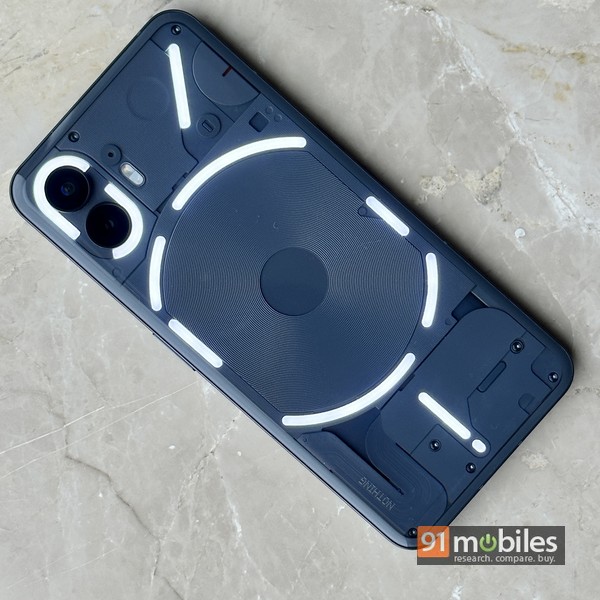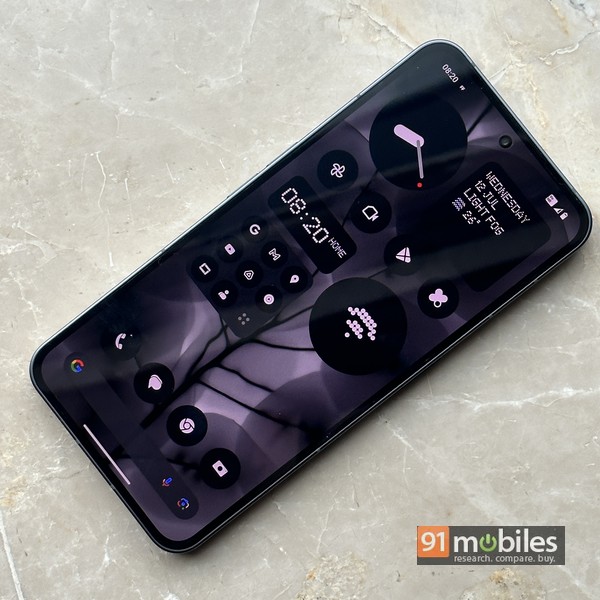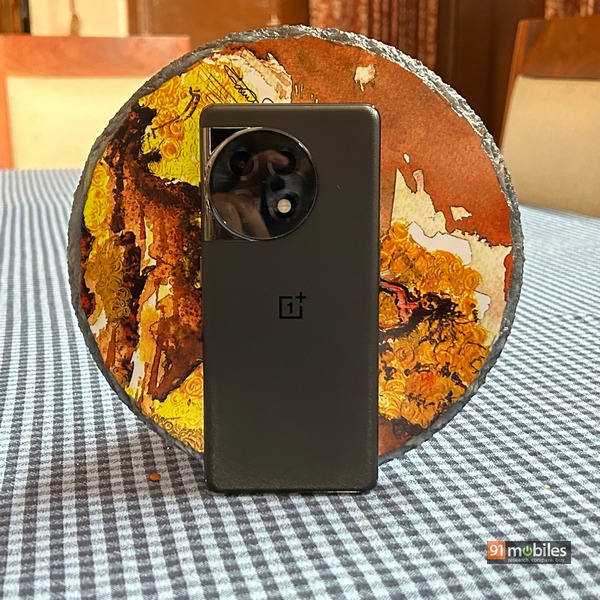
One is basking in the limelight of the smartphone stage. The other was an understudy to a higher profile flagship. Both come from brands that have a founder in common. Both believe in clean software and delivering great performance at affordable prices. Both have remarkably similar spec sheets. And both are priced within range of each other.
It is hardly surprising that folks with a budget of Rs 40,000-45,000 seeking a super smartphone are wondering whether they should invest in the slightly senior OnePlus 11R or the latest and greatest Nothing Phone (2). Given just how similar and yet different the two devices are, it is not an easy call to take. Let us try and sort out which one works better for you:
Table of Contents
Design and Appearance: OnePlus 11 clone against improved Phone (1) clone

Both the Nothing Phone (2) and the OnePlus 11R will stand out from other phones in their segment. And yet, both run the risk of being mistaken for their siblings. The OnePlus 11R is an almost carbon copy of the OnePlus 11, with the large spherical camera unit on the back and curved sides, while the Phone (2) at first glance seems very similar to the Phone (1), with a transparent-ish back and straight sides. However, a closer look reveals them to be different. The OnePlus 11R has no Hasselblad branding on that camera unit and its frame is a plastic one, while the Phone (2) is a bit larger than its predecessor and has a slightly curved back rather than a flat one, and can no longer be accused of being an iPhone clone. Which one looks better? Well, it really depends on your perspective, as both exude premiumness. The OnePlus 11R’s black variant comes with a sort of understated elegance that many will like, but if you are one that wants the world to turn and look at your phone, the Nothing Phone (2) is the phone for you. That transparent back and those flashing LEDs will grab attention, as will that rather different widget-laden front. 
The Phone (2) is also a bit more compact (162.1mm tall as compared to 163.4mm), and slightly slimmer (8.6mm against 8.7mm), although it is a little wider (76.4mm against 74.3mm). Neither phone is light – the OnePlus 11R weighs 204 grams and the Phone (2) weighs 201 grams. The Nothing Phone (2) also has smaller bezels around its display but the difference is not very clear at a casual glance. The same goes for its metal frame, which has a more premium feel than the carbonate one of the OnePlus 11R but is difficult to spot at a glance. While both phones come with Gorilla Glass protection, the Phone (2) comes with IP54 splash, water and dust resistance which the OnePlus 11R lacks. We are going with the transparent and lit back of the Nothing Phone (2). It may not be radically different from its predecessor, but there is still no other phone quite like it.
Winner: Nothing Phone (2)
Display: (AMO)Led by Refreshing rates!
![]()

The Phone (2) comes with a 6.7-inch FHD+ OLED LTPO display, while the OnePlus 11R comes with a 6.74-inch fluid AMOLED display. Both have a refresh rate of 120Hz, but the Nothing Phone (2)’s display can move from 1Hz to 120Hz refresh rate, depending on the content being displayed on it, while the OnePlus 11R can move between 40Hz, 45Hz, 60Hz, 90Hz and 120Hz. We felt the OnePlus 11R’s display seemed a little more vibrant in terms of colour handling, although the Nothing Phone (2)’s display seemed slightly more bright. These are two very good displays, but we are picking the Nothing Phone (2) for its more versatile refresh rate.
Winner: Nothing Phone 2
Processor: Chip Chaps

This is a tie. Both phones are run by the same processor – the Qualcomm Snapdragon 8+ Gen 1. This is still a flagship-level chip although almost a year old.
Winner: Tie
RAM and storage: Committing mega and giga-bytes to memory
![]()

This is where it gets interesting. For, while one phone scores in the RAM department, the other holds the edge in storage. The OnePlus 11R has two RAM and storage variants – 8GB/ 128GB and 16GB/ 256GB. The Nothing Phone (2) on the other hand has three variants – 8GB/ 128GB, 12GB/ 256GB and 12GB/ 512GB. The OnePlus 11R uses LPDDR5x RAM and UFS 3.1 storage, but we do not have details on the kind of RAM and storage used by the Phone (2). It really boils down to what one values more – RAM or storage. The fact that neither phone comes with expandable memory makes storage even more important. We would prefer the 16GB RAM of the OnePlus 11R to the 512GB storage of the Phone (2), as it can actually change the performance levels of the device at the highest level, but it is a close call. In a perfect world, we would have liked a 16GB/ 512GB variant!
Winner: OnePlus 11R
Cameras: Say Cheese to Nothing or to a OnePlus?
![]()

Can two good cameras beat a single very good one, with two less able sidekicks? That sums up the cameras of the OnePlus 11R and the Nothing Phone (2). Both come with a 50-megapixel Sony IMX890 main sensor with OIS, but very different supporting sensors – the Phone (2) comes with a 50-megapixel ultrawide, while the OnePlus 11R has an 8-megapixel ultrawide and a 2-megapixel macro sensor. Both main cameras take very good shots with plenty of details, although with bright, slightly saturated colours, and are decent low-light performers. However, the gap opens up when you move to the other sensors. The Nothing Phone (2)’s ultrawide sensor delivers markedly better performance than the 8-megapixel one on the OnePlus 11R in terms of colours, detail and low light performance, and the 2-megapixel sensor on the OnePlus 11R contributes more to the spec sheet than to photography. Interestingly, we felt that the 16-megapixel camera of the OnePlus 11R actually delivered better selfies than the Nothing Phone (2)’s 32-megapixel front-facing camera. The OnePlus 11R also seemed to shoot slightly better video than the Nothing Phone (2), but the secondary wins this round for the Phone (2).
Winner: Nothing Phone (2)
Gaming and multimedia: Light, sound, game action!
With both phones running the same processor, it is hardly surprising that the gaming experience on both is very similar. The two phones also have stereo speakers and impressively bright displays, so titles like Genshin Impact and Call of Duty look quite spectacular on them and play quite smoothly too. We felt that games with vivid colours looked a little better on the OnePlus 11R, while minimalistic games like Alto’s Odyssey shone on the Phone (2). Both phones come with stereo speakers that deliver very good sound. Honestly, we could not tell a discernible difference in the gaming and multimedia performance on both phones – both are great for gaming and for viewing content. The OnePlus 11R has a slightly bigger display but it does not make a massive difference, and neither does the Phone (2)’s more versatile refresh rate.
Winner: Tie
Software: Breathe oxygen, or stay plain and be lit?

Both phones run on Android 13, and both try to serve up a relatively uncluttered version of Android to their consumers. And yet both are very different. The OnePlus 11R comes with OnePlus’ OxygenOS interface, while the Nothing Phone (2) runs on Nothing OS 2.0, which is very close to stock Android. Both phones with very little bloatware, and have added their own small tweaks to the interface, although Nothing OS 2.0 is closer to stock Android than OxygenOS. While we like both interfaces, the Nothing Phone (2) wins this round, thanks to its glyph UI interface on the back, which lights up in different patterns to let you know of notifications, who is calling, and can even show you the progress of a timer. No other phone has anything like it. Add to this the fact that the Phone (2) actually lets you choose between using stock Android and Nothing OS at installation stage, and the Nothing Phone (2) runs out a comfortable winner not only against the OnePlus 11R but pretty much every Android phone out there.
Winner: Nothing Phone (2)
General usage: Everyday things
With broadly similar configurations and clean interfaces, there is not too much that separates the performance of the two phones in everyday functions like browsing the web, keeping track of social networks, emails and messaging. We used 12GB RAM versions of both phones and both ran smoothly and were superb at multi-tasking too. The fingerprint sensor on the Phone (2) had a few issues initially but an update seems to have sorted them out at the time of writing. Both phones come with 5G support and have Bluetooth 5.3. The OnePlus 11R does have an IR blaster, which the Phone (2) lacks, but we do not think that does enough to win it this round, which we are calling a tie.
Winner: Tie
Battery and charging: Watt the mAh!
![]()

This is a fascinating round, with each device bringing its own battery strengths to the table. The OnePlus 11R wins the mAh battle, with a 5,000mAh battery as compared to the 4,700mAh one on the Nothing Phone (2). The OnePlus11R also comfortably goes past a day of heavy use, while the Nothing Phone (2) will get you through a day. The OnePlus 11R also comes with support for 100W SuperVOOC charge and a 100W charger in the box, which charges the phone from 0 to 100 in about thirty minutes. The Phone (2) on the other hand comes with 45W support, and has no charger in its package. It takes about an hour to charge with a 45W charger. Given all this, you would think that the OnePlus 11R wins this one easily. The Nothing Phone (2), however, comes with support for wireless charging, something which even the flagship OnePlus 11 lacks. It comes with 15W wireless charging (it takes two and a half hours to charge with a 15W wireless charger) and also has 5W reverse charging, which lets you charge devices off its back. We love the inclusion of wireless charging in a device at this price point, but the faster charging, fast charging adapter and better battery life of the OnePlus 11R win this round for the Never Settler.
Winner: OnePlus 11R
Price: Tag that price!

In terms of pricing, the OnePlus 11R has a very clear edge over the Nothing Phone (2). The OnePlus 11R starts at Rs 39,999 for its 8GB/ 128GB variant, while its 16GB/256GB variant is priced at Rs 44,999 – the exact price at which the Nothing Phone (2) starts. The Nothing Phone (2) starts at Rs 44,999 for the 8GB/ 128GB variant and also has a 12GB/ 256GB variant (which the OnePlus 11R does not) for Rs 49,999. The top variant of the Nothing Phone (2) has a RAM and storage combination of 12GB/ 512GB and is priced at Rs 54,999. You can get the top OnePlus 11R for the price of a base Nothing Phone (2). Only one(plus) winner here.
Winner: OnePlus 11R
Verdict: Never Settler or Nothing?
As you can see, the battle between the two phones is a rather close one – the Phone (2) wins on four parameters,, the OnePlus 11 wins three and three are tied. This might seem to give the Phone (2) a slight edge but it is notable that three of the rounds many might consider most crucial in making purchase decisions – everyday use, gaming and processor – are tied. The OnePlus 11R also wins two very vital rounds – battery and price. That said, the Nothing Phone (2) grabs the design, display, camera and software rounds, which are crucial to many users.
So which of the two phones should you go for?

In terms of sheer value for money, we have to say that the OnePlus 11R seems the better proposition – you get a 16GB/ 256GB variant of the OnePlus 11R for the price of the 8GB/ 128GB variant of the Nothing Phone (2). The fact that the OnePlus 11R matches the specs and performance of the Phone (2) tilts the balance further in favour of the Never Settler with the R, especially when you factor in the fact that you get a charger (and a pretty fast charger) in the box as well. But then the Nothing Phone (2) is a phone like none other in terms of its transparent design and that Glyph UI on its back, and also comes with one of the cleanest Android interfaces this side of the Pixel. It also has a better secondary camera.
We will keep it simple: if you have a budget in the vicinity of Rs 50,000 and are looking for a phone that stands out loud and proud in the sea of smartphone sameness, then the Nothing Phone (2) is easily your best bet. However, if you are looking for getting the most bang out of your smartphone buck, then the OnePlus 11R is the device for you.
Whether you opt to Never Settle, or go all for Nothing, you will end up with a super phone!












